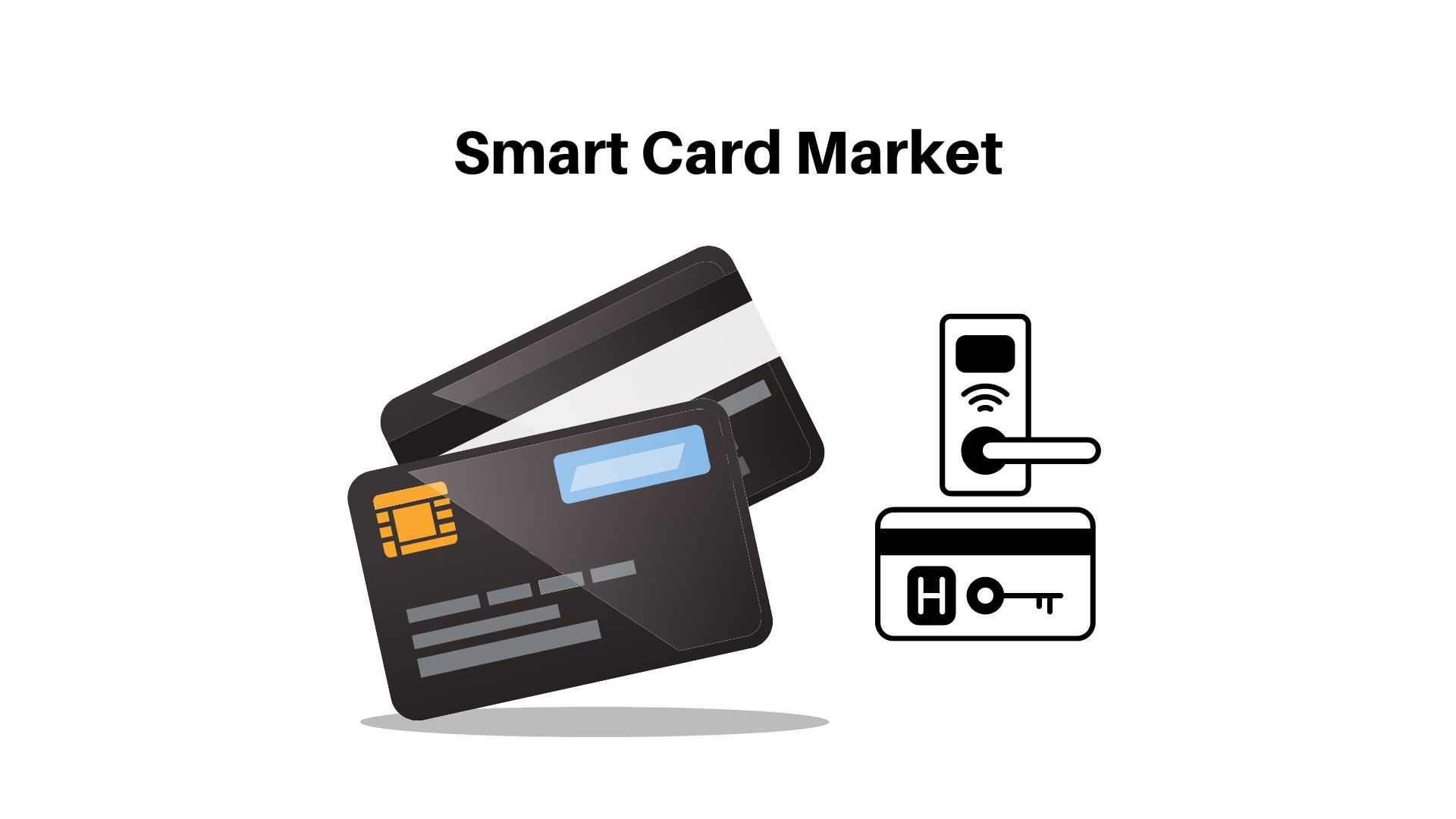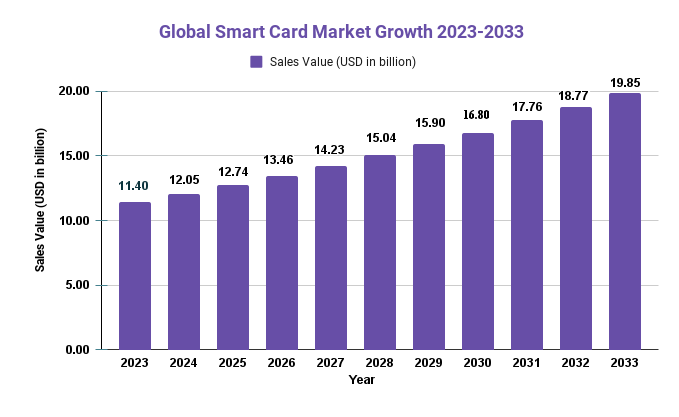Smart Card Market is estimated to be worth USD 19.85 Billion by 2033 | CAGR of 5.7%

Page Contents
Smart Card Market Overview
According to the most recent research conducted by Market.us, the revenue of the worldwide smart card market is projected to reach USD 11.40 billion by the end of 2023. Looking ahead to the longer term, the market is anticipated to grow to around USD 19.85 billion by 2033, growing at a CAGR of 5.7% from 2023 to 2033.
The global smart card market is a rapidly growing industry that includes a range of card-based technologies used for secure and efficient transactions. Smart cards are used in a variety of applications, including banking, transportation, identification, and access control. The market is driven by factors such as the increasing adoption of contactless payment systems, rising demand for secure and efficient payment solutions, and government initiatives promoting the use of smart cards.
Rising Demand and Growth
The increasing adoption of contactless payment systems and the growing demand for secure and efficient payment solutions are the major factors driving the growth of the market. The market is also expected to be driven by the increasing demand for smart cards in the healthcare sector and the growing popularity of mobile payment systems.
Because they offer privacy and confidentiality, smart cards are used widely in healthcare, transport, BFSI and other verticals. Due to the increase in demand for tap-to-pay (contactless smart card) payments, the global smart card market is expected to expand rapidly. The market is experiencing significant growth due to the increased use of smart cards for personal identification and access control. Market growth is also being driven by technological advancements and digitalization across various industries. The global smart card market will see many opportunities as a result of the expansion in the retail and ecommerce sectors. To improve card performance and simplify manufacturing, market players have launched high-performance biometric smart cards platforms.
Market Trend
The trend in the smart card market is shifting towards the adoption of new and advanced technologies, such as biometric authentication and cloud-based solutions. Smart card manufacturers are increasingly focusing on the development of more secure and efficient payment solutions, including contactless payment cards, mobile payment solutions, and wearable payment devices.
Key Takeaways
- The increasing adoption of contactless payment systems and the growing demand for secure and efficient payment solutions are the major factors driving the growth of the market.
- The market is also expected to be driven by the increasing demand for smart cards in the healthcare sector and the growing popularity of mobile payment systems.
- The trend in the smart card market is shifting towards the adoption of new and advanced technologies, such as biometric authentication and cloud-based solutions.
Request For Sample Report Before Purchasing: https://market.us/report/smart-card-market/request-sample/

Regional Snapshot
- Due to rapid industrialization and urbanization in China, India and Japan, Asia Pacific will be the fastest-growing smart card market during the forecast period. The region's rapid growth in e-commerce is also driving demand for smart card.
- North America and Europe will account for a significant portion of the global smartcard market. Due to increased consumer spending via digital media, South America's smart card market is expected to expand at a rapid pace. In the coming years, there will be significant growth in smart card sales in Middle East and Africa. The region is expected to see a rise in adoption of advanced technology that will drive smart card demand.
Drivers
- Increasing adoption of contactless payment systems
- Rising demand for secure and efficient payment solutions
- Government initiatives promoting the use of smart cards
- Growing demand for smart cards in the healthcare sector
In COVID-19, there is a strong demand for contactless (tap and play) payments
- Before the pandemic, consumer awareness of the benefits of tap and pay cards and their use was on the rise. The spread of COVID-19 and the outbreak of the pandemic led to a rapid rise in contactless payments.
- People are able to purchase groceries and household goods using contactless payment options, despite having limited contact and social distancing due to the pandemic. Consumers want to minimize their exposure during transactions. Fiserv (US), May 2020 research shows that people view tap-and-pay cards as the most secure and fastest way to pay.
- A Harris Poll survey was conducted for Fiserv in May 2020. It found that ~41% of respondents considered tap-and pay credit cards to be the most secure in terms of preventing the spread.
- At ~5.9% and ~4.2% respectively, consumers considered cash and checks the least secure in preventing the spread COVID-19. The survey found that tap-and-pay has been perceived as the most secure, preferred and convenient payment method. This perception has increased since 2019.
Interested to Acquirethe Data? Inquire here at https://market.us/report/smart-card-market/#inquiry
Restraints
- High implementation and maintenance costs
- Security concerns related to data breaches
- Limited awareness about the benefits of smart cards in some regions
Security and data theft are two of the major concerns with high infrastructure costs.
- Because of the many advantages they offer, smart cards have been attracting a lot more attention from consumers in recent times. But, the cost of smart cards is one of the main factors that limit the market's growth.
- High initial capital investment is required to create smart cards for access control and other purposes.
- Smart cards require readers that can read encryptions to obtain the information necessary to give physical or logical entry.
- Additional costs are involved in the deployment of these readers. Smart card readers cost an average of USD ~50 to USD ~310. The cost of smart cards is between USD ~2-10. The cost of smart cards ranges from USD ~2 to USD ~10.
- Chips with high capacities and advanced capabilities increase the card's costs. It is likely that multifunctional smart cards for employees will require greater initial investments than traditional cards.
Opportunities
- The growing popularity of mobile payment systems
- Increasing adoption of smart cards in the healthcare sector
- Rising demand for biometric authentication and cloud-based solutions
Blockchain enables a new mode of information security for users
- Blockchain technology is revolutionary and allows businesses to develop secure, fast applications that meet stringent security requirements. Smart cards are capable of securely managing cryptographic keys and allowing for efficient and secure transactions in Blockchain applications. They can be used as vaults to store cryptographic keys.
- The keys can be matched to keys in online libraries by connecting smart cards to the Internet via POS readers. Users are authenticated if the match succeeds. This will enable banks and other ecosystem players to authenticate users' identities in a more efficient manner. It is also expected that this will reduce cyber thefts.
Challenges
- Increasing competition in the market
- Difficulty in maintaining security and privacy of data
- Limitations in terms of processing power and memory of smart cards
Digital identity cards are gaining popularity
- Digital identity cards can be used as an electronic version of ID cards. Digital identity cards are able to be authenticated remotely via digital channels, unlike paper-based cards like driving licenses or passports. This allows them to access banking services, government schemes, and educational facilities. In the coming three to four years, mobile devices are expected to be used as digital ID cards for enterprise services and data.
- Digital identity cards are easy to obtain and more affordable than ever. This allows emerging economies to avoid paper-based identification. As governments across the globe adopt this technology to identify their citizens and meet their needs, there is a growing demand to digital identity cards.
Recent Developments
- In January 2022, Thales Group, a French multinational company that provides security and defense technologies, launched a new smart card solution called Cinterion Secure Element. The solution is designed to secure IoT devices and enable secure data exchange between them.
- In December 2021, Infineon Technologies, a German semiconductor manufacturer, announced that it had achieved certification for Common Criteria EAL6+ for its smart card controller. This certification is the highest level of security evaluation for IT products and is a significant achievement for Infineon.
- In November 2021, NXP Semiconductors, a Dutch semiconductor manufacturer, announced that it had launched a new family of smart card chips called SmartMX3. The chips are designed to enable secure and convenient digital transactions, and offer enhanced performance and security features.
A comparative analysis of the Smart Card Market and its adjacent markets:
Contactless Smart Card Market
| Report Attribute | Contactless Smart Card Market |
| Revenue forecast by 2033 | USD 21.17Bn |
| Growth Rate | CAGR Of 4.0% |
| Growth Factors |
|
| Opportunities |
|
| Key Trends |
|
Dual Interface Smart Card Market
| Report Attribute | Dual Interface Smart Card Market |
| Revenue forecast by 2033 | USD 301.94 Bn |
| Growth Rate | CAGR Of 6% |
| Growth Factors |
|
| Opportunities |
|
| Key Trends |
|
Market Segmentation
Type
- Genuine Leather
- Synthetic Leather
Application
- Men
- Women
Key Market Players
- Nike
- Adidas
- Puma
- Skechers
- Under Armour
- Mizuno
- VF
- Guirenniao
- Billabong
- Anta
- Li-Ning
- BasicNet
- ASICS
- Xtep
- 361 Degrees
- Lululemon
- Peak
- Wilsons Leather
Frequently Asked Questions:
What is the size of the global smart card market?
Ans: The global smart card market size is expected to reach USD 25.5 billion by 2027.
What are the key factors driving the growth of the smart card market?
Ans: The key factors driving the growth of the smart card market include the increasing adoption of contactless payment systems, rising demand for secure and efficient payment solutions, and government initiatives promoting the use of smart cards.
What is the major trend in the smart card market?
Ans: The trend in the smart card market is shifting towards the adoption of new and advanced technologies, such as biometric authentication and cloud-based solutions.
Purchase This Report Via Secured Link and Avail Discount@ https://market.us/purchase-report/?report_id=19653
Report Scope
| Report Attribute | Details |
| Market size value in 2023 | USD 11.40 billion |
| Revenue forecast by 2032 | USD 19.85 billion |
| Growth Rate | CAGR Of 5.7% |
| Regions Covered | North America, Europe, Asia Pacific, Latin America, and Middle East & Africa, and Rest of the World |
| Historical Years | 2017-2022 |
| Base Year | 2022 |
| Estimated Year | 2023 |
| Short-Term Projection Year | 2028 |
| Long-Term Projected Year | 2032 |
Contact us
Contact Person: Mr. Lawrence John
Market.us (Powered By Prudour Pvt. Ltd.)
Tel: +1 718 618 4351
Send Email: [email protected]
The team behind market.us, marketresearch.biz, market.biz and more. Our purpose is to keep our customers ahead of the game with regard to the markets. They may fluctuate up or down, but we will help you to stay ahead of the curve in these market fluctuations. Our consistent growth and ability to deliver in-depth analyses and market insight has engaged genuine market players. They have faith in us to offer the data and information they require to make balanced and decisive marketing decisions.